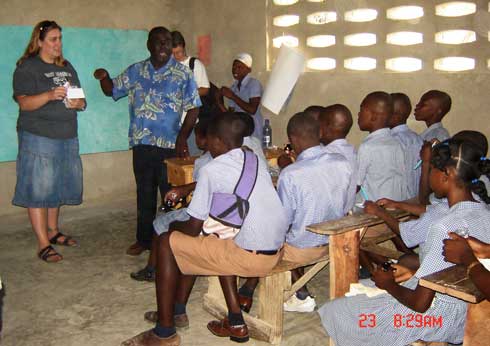
"Our science teacher, Guen Vinnedge traveled to Haiti last week with three other individuals from Saint Mark’s Episcopal Church. Our school, Saint Mark's Episcopal School in Upland, has adopted Saint Andres as our sister school and has raised money for a water system, a building and for school uniforms. More importantly, our children have forged a relationship with the students of Saint Andres through the creation of friendship bracelets, seed packets, photographs, banners, and now fingerprints!
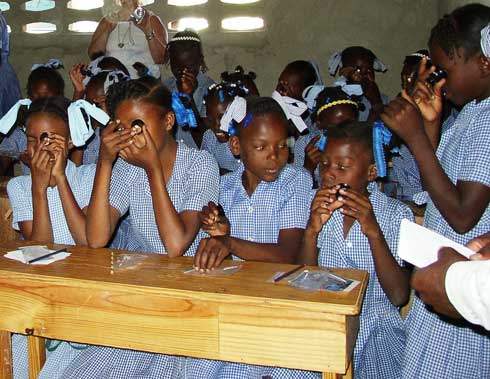
Guen Vinnedge transported the 250 loupes and index cards with loupe look finger prints from our students to share with the students of Saint Andres. Both were a big hit and Ms. Vinnedge returned with fingerprints from the students of Saint Andres. Our students are amazed that learning happens in such crowded classrooms with so few materials. We are all impressed with the joy and enthusiasm that is clearly expressed in the photos I have attached.
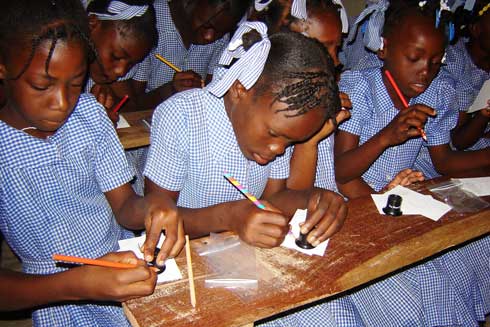
These are students with so very little in the way of material goods, most eat their one and only meal that day in school and share single room homes with extended families. The loupes will bring an enrichment to their educational program and a means of exploring their natural world in new and fresh ways.
Thank you for partnering with us to make this happen in Haiti."
Sincerely,
Denise Gideon
Director of Curriculum
Saint Mark's Episcopal School, Upland
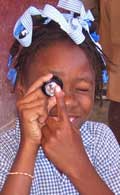
_______________________________________________________________________
JUDY RECTOR
Teacher (30 year classroom veteran), Leavenworth, WA
Recipient of Mona Foundation and www.hopeislife.org Grant Awards
We had great experiences in Haiti, sharing a new way to look at the world. All of the teachers and students we shared with at the Anis Zunuzi School in Lilavois, Haiti, had never used a magnifying glass of any kind before. They found working with a tool that enlarged things fascinating! One little boy came into the room as I was setting up for a teacher's
training. I gave him a loupe and showed him how to focus on his hand. He
jumped back and shook his hand and said, "GWO!" which in Creole means "BIG"! Then he wanted to see other things close up.

There were 18 teachers trained in the use of the loupes for grades K-12. The whole idea of using a tool like this to investigate (science), write about what they see (language) and draw what is seen (art), thus integrating their lessons, making connections in the world around them. Integration is a new concept to Haitian teachers. Education there is very
compartmentalized and rarely overlaps, so this idea was fresh to them. None of the teachers at this school had ever held a paintbrush or used any other art medium except markers and crayons so painting their loupe drawings was a truly unique experience. The results were amazing! I feel Haitians are a naturally artistic people and they loved this activity.
When I asked them to list what their fingerprints reminded them of, they did a great job making a long list, but then when I asked them to draw their fingerprint, many of them drew pictures of what it reminded them of, not their original print! So something was definitely 'lost in translation!' I learned this with the first group I worked with and made
it very clear after that what was expected in their first drawings. I worked with two schools and a group of students in an orphanage and all were very receptive to learning in this fun way.
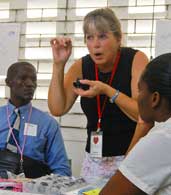
-------------------------------------------------------------------------------------------------------------------
"Teacher Education in Haiti with The Private Eye "
Denise Gideon
Saint Mark's Episcopal School, Upland, CA
A KISA SA-A SANBLE? KISA SA-A RAPLE OU?
(What else does it remind me of? What else does it look like?)
When the Ministry of Education in Haiti determined that teachers would be required to work toward certification, Denise Gideon, adjunct faculty member at the University of Redlands and long-time advocate of The Private Eye Loupe program, recognized the challenge this presented for the teachers she works with in rural Haiti. For these teachers, earning less than $900 US annual salary, professional development and advanced degree coursework is beyond their reach. Yet, without these teachers and their dedication, the children in their isolated communities would not receive an education.
It might take a whole village to raise a child but to provide University coursework to 18 teachers scattered throughout the Central Plateau region of Haiti, it takes even more people working together. First, the University of Redlands waived the usual tuition fees and offered university credit toward certification. Next, the Zanmi Lasante facility agreed to house and feed the teachers for the week-long 40 hour program. The Private Eye provided materials and the FARforareason.org foundation raised funds for translators, materials and class sets of supplies for participating teachers.
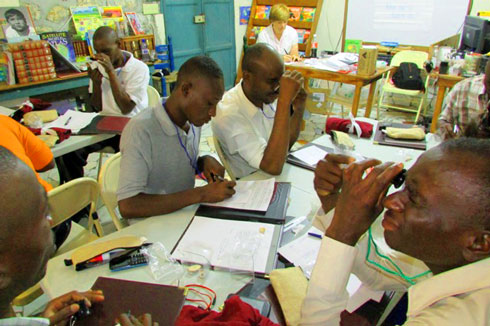
And so, on June 29, 2015, 22 educators and 2 translators met in Cange, Haiti to examine educational practice and methodology. The teachers were introduced to Piaget, Vygotsky, and Gardner. They learned about best practices and embraced the new information, discussing how best to implement them in their classrooms. But the real magic began when the loupes came out. From the moment the Loupe lanyards were placed around the teachers’ necks scientific investigation became possible, practical and professional. In classrooms without running water and electricity and for teachers without textbooks, microscopes and materials, The Private Eye Loupes opened up a world that was academic and culturally relevant. Teachers explored fabric construction and analyzed why some were more conducive to clothing in Haiti than others.
They gathered specimens for their collection boxes and compared dragonfly wings with those of butterflies. Leaves and flowers were analyzed for function. Everything was examined for the sheer intricate beauty of the “up-close.” Add colored pencils to the mix and an exciting, culturally relevant program emerged that renewed teacher respect and appreciation.
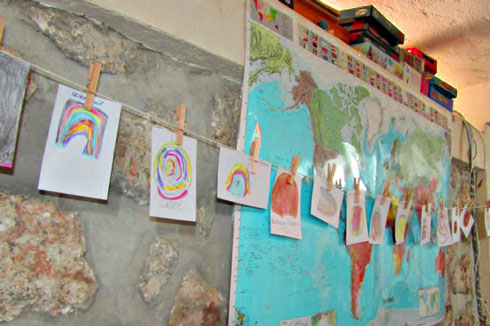
By the end of the week, friendships had been established and dialog continues thanks to the internet. US teachers and Haitian teachers understand that we are more alike than different, that children everywhere need and respond to the same things, and that with tools as simple as a plastic jeweler’s loupe, the world can open up and be explored in ways that educate and generate hope and promise for a better future.
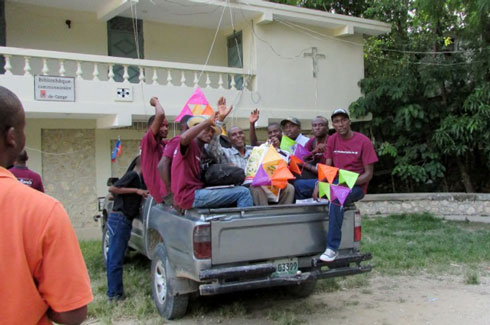
Teachers head home after a week of university coursework armed with projects, materials and enthusiasm for a new school year. Seventeen of the teachers crammed into that truck to get to the place where they would begin their walks (some as long as 20 miles) home.
GROUP FINGERPRINT POEM
I think this is an accurate translation ( I had some trouble reading handwriting) of the first group poem written after our first introduction to loupes and the examination of finger prints.
A stone dropped in the stillness of a lake
Or a finger print |
Yon roch ki tonbe non yon lak trankil
Se tankou yon pwent dwet |
| A spider web stretched between two flowers |
Yon filareye zariyen nan mitan de fle |
| Or a fingerprint |
Se tankou yon pwent dwet |
| The rings of a tree, or a waterfall |
Ron’n ki nan bwa yo, dlo kap tonbe nan so yo |
| Or a ball of twine |
Yon ploton fise |
| Or a fingerprint |
Se tankou yon pwent dwet |
| The Farmer’s rows and rows of crops |
Le kiltivate yo ap range kloti yo, rekot yo |
A bowl of spaghetti
The edge of a book
A Tongue
The lines on the face of a grandmother
Or a fingerprint |
Yon bol espageti
Le wap pase fey liv yo
Yon lang
Pli kinan figi on ti granmoun
Se tankou yon pwent dwe |
All the world
In our fingerprints |
Nou tout net
Nan pwenet dwet nou |
|
